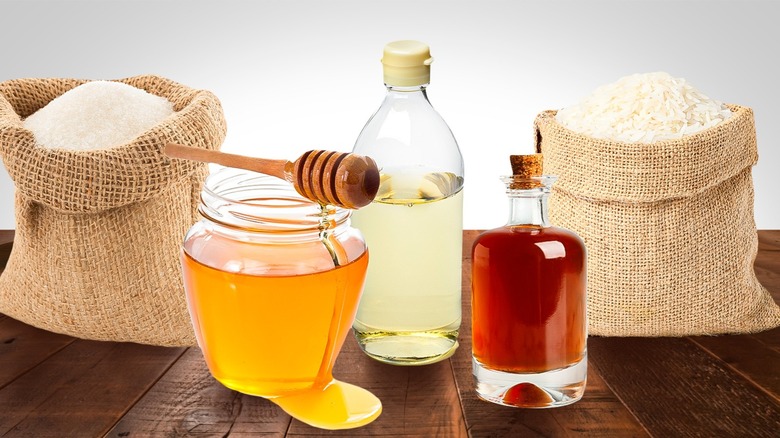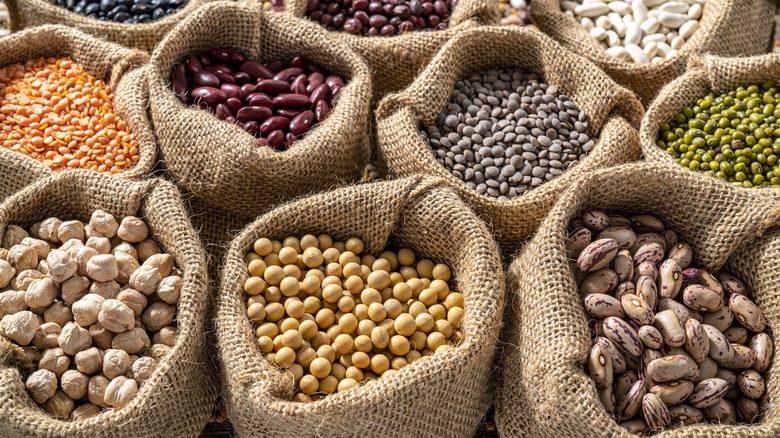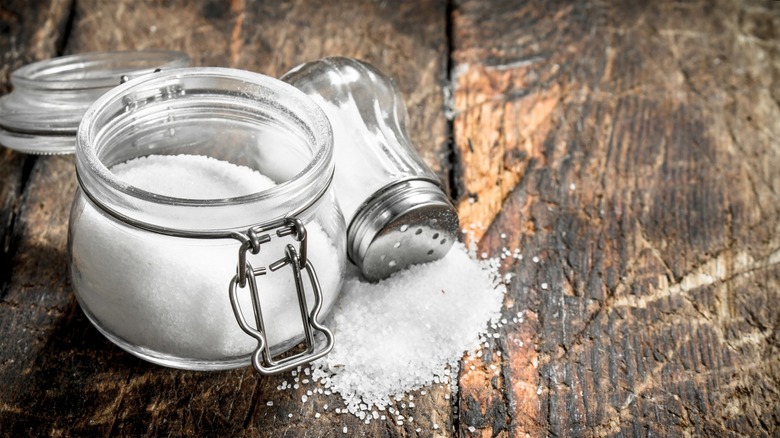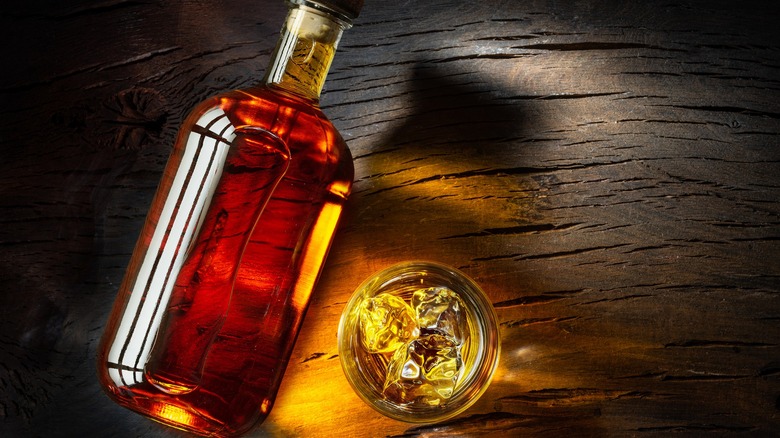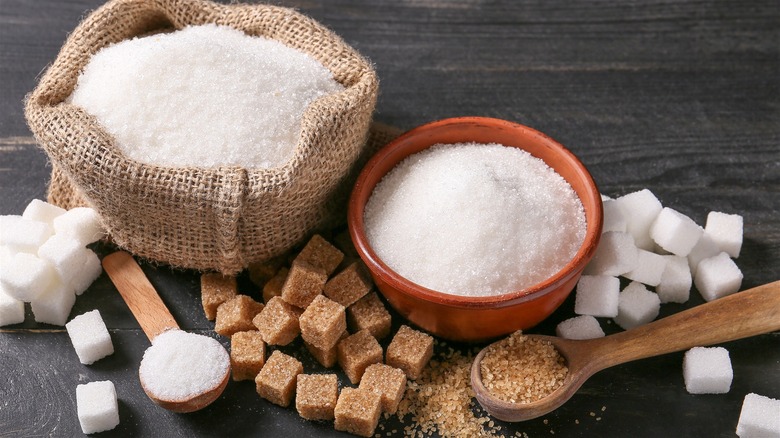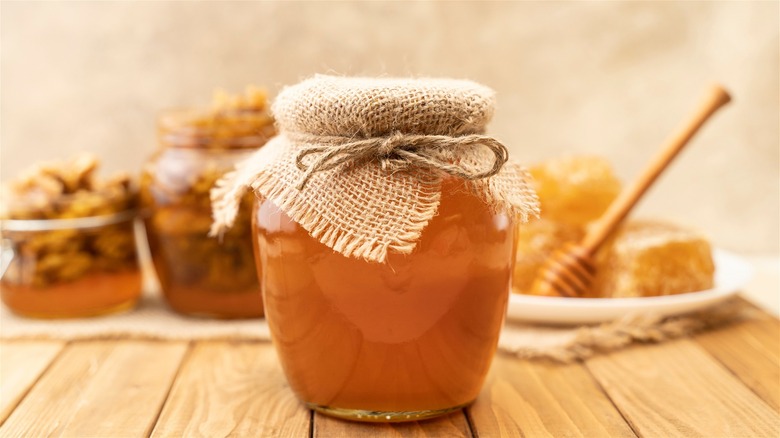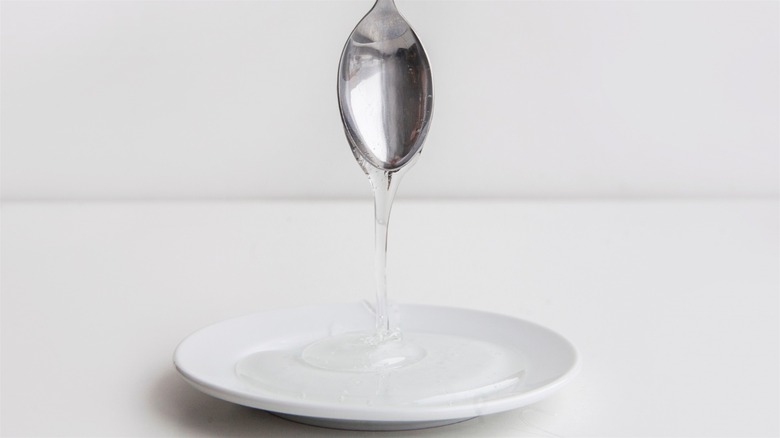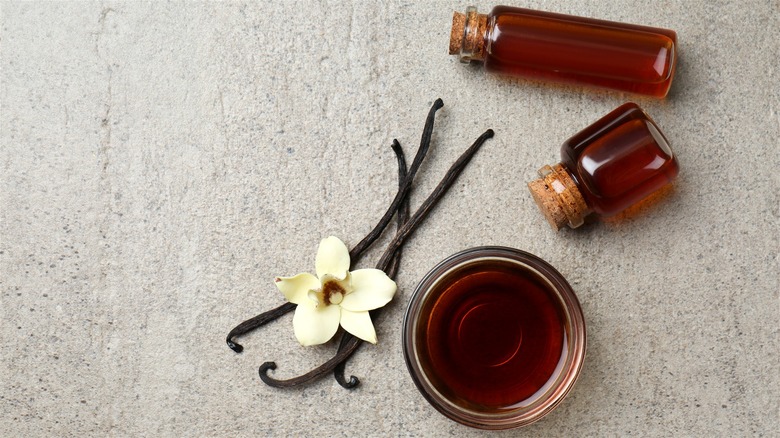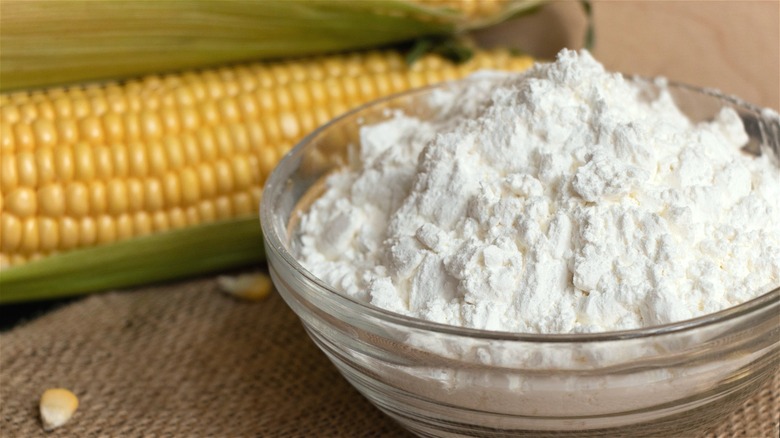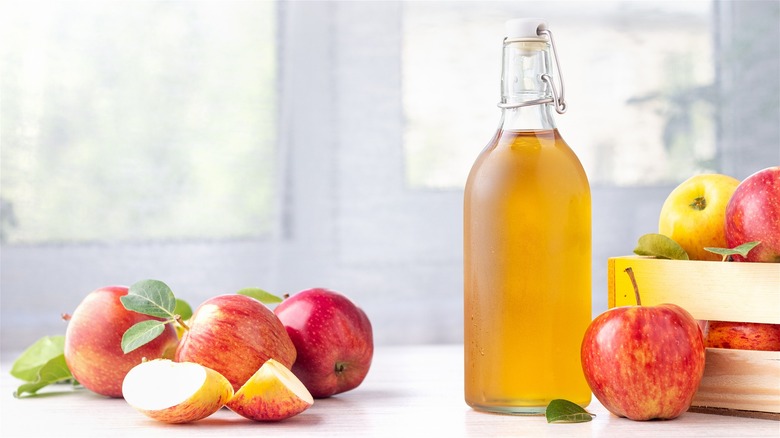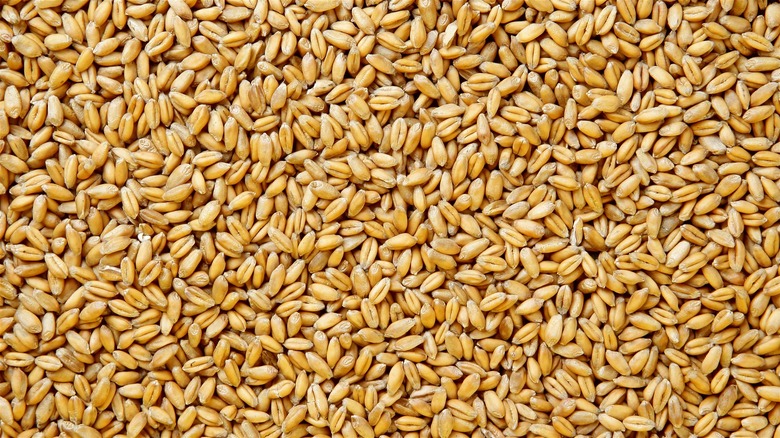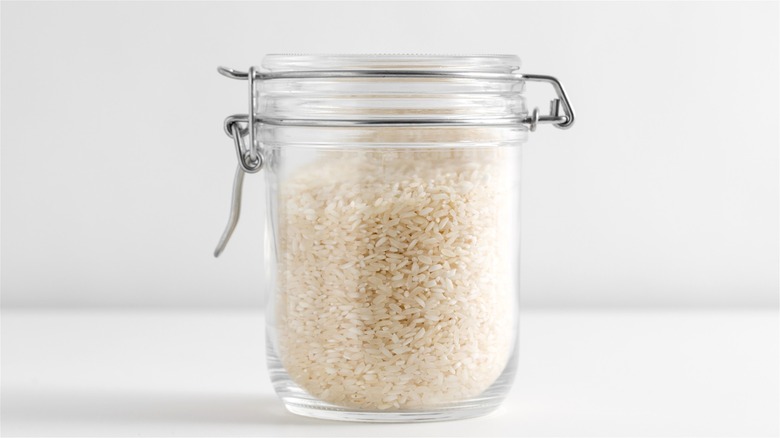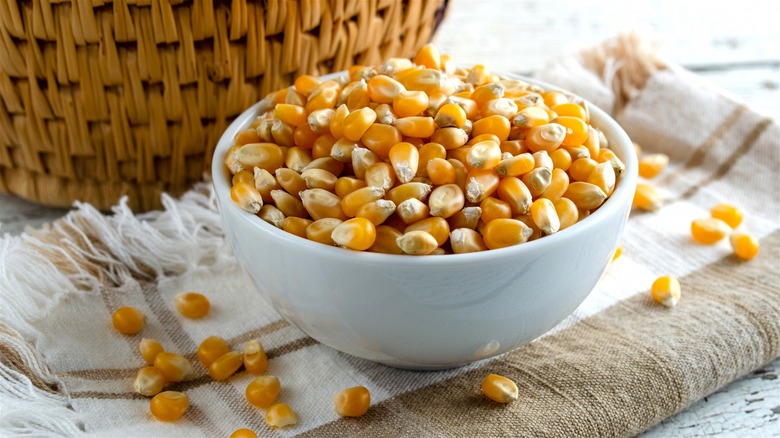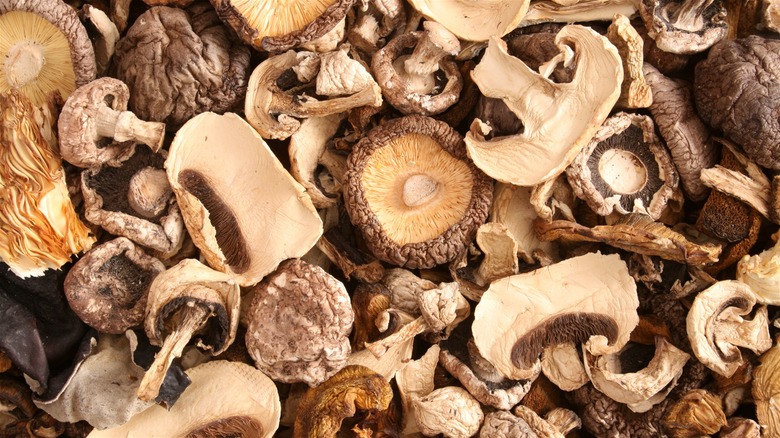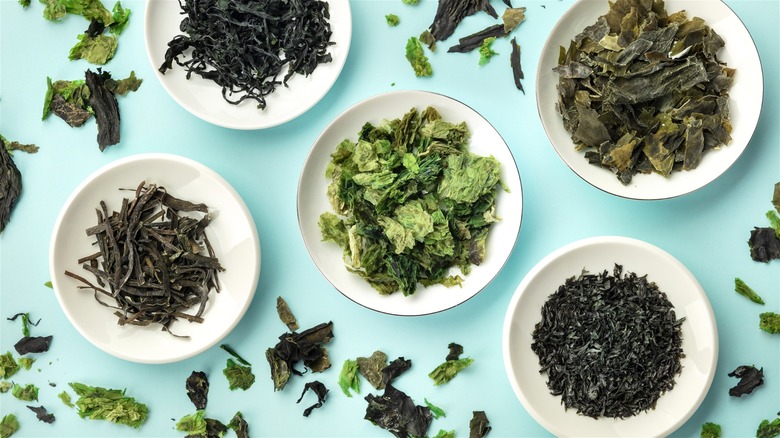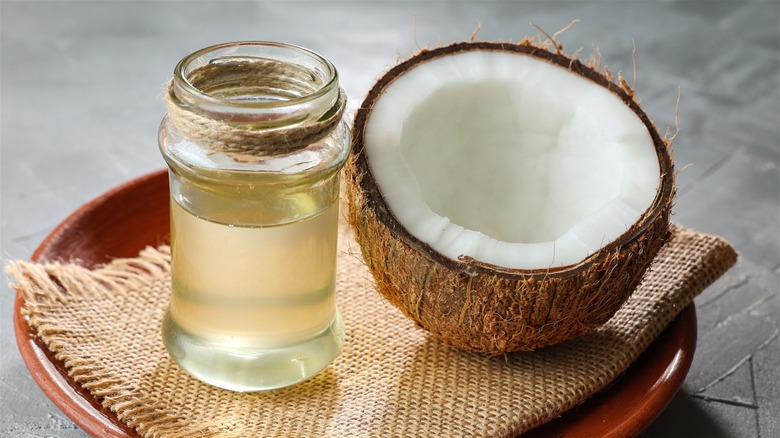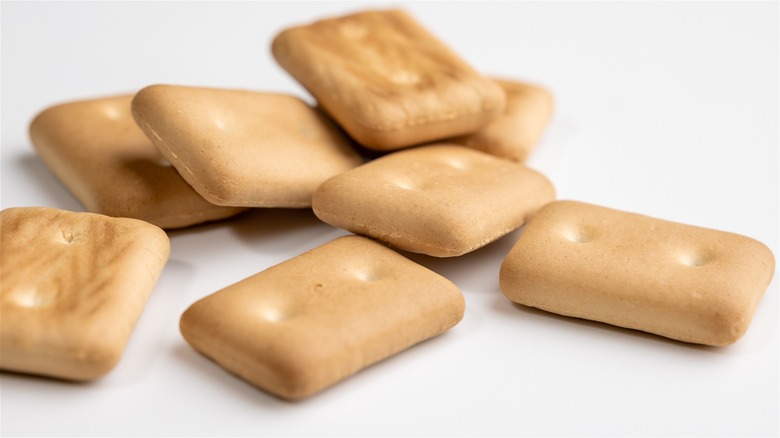16 Pantry Items That Have The Longest Shelf Life
Some people say age is just a number. We say, so are the expiration dates printed on most pantry staples. They might as well be drawn in sand rather than set in stone, as they often signal peak freshness rather than the onset of spoilage. Originally intended to guide stores rather than consumers, they've morphed into misunderstood deadlines that lead to unnecessary waste. Most non-perishable foods are perfectly edible after their sell-by or best-by dates. With that in mind, you should stop throwing out expired foods, particularly those designed to defy time, either through their natural resilience or through human preservation efforts.
As essential as light, oxygen, and water are for humans to survive, they are known enemies of long-term food storage; so it's a good idea to shelter naturally shelf-stable pantry staples from these factors. So, items like vinegar or dried mushrooms are economical and long-lasting, when they are properly stored. So, it seems stocking your shelves with such enduring essentials isn't just for doomsday preppers!
1. Dried legumes
No well-stocked pantry would be complete without legumes in some way, shape, or form. They're an excellent source of plant-based protein and have a versatile culinary repertoire. Now, you may be wondering if dried beans expire, and the answer is yes and no. They can indeed remain edible for almost 30 years if stored properly in undamaged packaging, according to a study by Brigham Young University on pinto beans.
But, even if you take all necessary precautions, like keeping them away from light and oxygen, dried beans will eventually deteriorate over time. For one thing, they will lose all their vitamin content by the 5-year mark. Long-term storage can mean they'll often take longer to cook especially if you need to soak them over night. With that in mind, if you keep dried legumes in airtight containers away from oxygen, light and heat, you should be able to enjoy them for several years without compromising too much on quality.
2. Salt
Not only is salt accessible, universal, and essential for our bodies, but pure salt never expires because it is a mineral. Now, does this apply to any type of salt? Unfortunately, no. Only pure salt will stand the test of time and remain completely unchanged. Table salt can go bad after a few years due to the presence of iodine and anti-caking agents will reduce in quality over time, while seasoned salts will lose their flavor potency, but remain edible.
Luckily, most salts have an infinite shelf life. Kosher, flaky, Himalayan, rock, and sea salts used in day-to-day cooking are all pure enough to last a lifetime as long as you store them correctly. For small-scale storage, use rice to prevent salt from clumping. The grains are hygroscopic, meaning they'll draw out any moisture, so adding some to a salt shaker will promote an even flow. Otherwise, keep your salt in an airtight container and enjoy it forever.
3. Hard liquor
Not usually considered a pantry item, alcohol has plenty of culinary applications, from penne alla vodka to rum-raisin ice cream. A liquor cabinet stocked with distilled spirits, such as whiskey, vodka, gin, rum, and tequila, can be enjoyed for generations provided you store them at room temperature and away from sunlight. Their high alcohol content, as well as lack of sugar and other additives, contribute to an indefinite shelf life.
It doesn't matter if you got them years ago – those beverages don't age in their sealed containers, unlike wine and beer, which usually have less alcohol content or liqueurs diluted with sugar and other additives. As for how long liquor lasts after opening the bottle: Whiskies and other distilled spirits can remain drinkable for 6-24 months (except vodka, which will be good for a decade or two). However, you might notice some flavor loss and diminished alcohol content in vodka after roughly 20 years.
4. Sugar
On its own, sugar is similar to salt in that has an indefinite shelf life. And again, like its white granular cousin, sugar has no natural moisture but can draw it out from other foods so bacteria can't thrive on it. Sugar is a key ingredient in fruit preserves, which helps them last for years. So, if you've been wondering whether it's safe to eat expired sugar, remember that this sweet companion to your morning coffee never spoils, despite what's printed on the box.
Of course, you'll still need to store it properly — you can never go wrong with an airtight container kept away from light and heat. Not only does it prevent clumping by cutting sugar's access to airborne moisture, but it also keeps away pests and unwanted odors. However, despite the promise of a lifetime of sweetness, most types of sugar are best used within two years of opening. They won't be off after that time, but you might notice some deterioration past the two-year mark, especially if not stored correctly.
5. Honey
Another valuable addition to the survivalist pantry, honey is famous for its long shelf life. Open or closed, a jar of honey never expires. What's its secret? A chemical cocktail that deters bacteria. For one, it's dense with sugar, a natural preservative. It's also quite acidic, with a pH hovering around 4, giving it antibacterial properties. When bees craft this golden nectar, they add an enzyme called glucose oxidase, which, when mixed with moisture, produces hydrogen peroxide, a disinfecting product.
The best way to keep honey fresh is to store it in a sealed glass container at room temperature. While the USDA recommends using it up within a year, older honey that's turned cloudy or crystalized is still perfectly safe to eat. Crystalized honey can be reversed by warming it up in a glass jar placed in a tub of warm water (95-110 degrees Fahrenheit is ideal). Stir it occasionally over an hour, and you'll restore it to its former glory.
6. Corn syrup
Unfortunately, the bee's labor in producing honey makes it unsuitable for the vegan pantry. Still, there is one plant-based liquid sweetener with an indefinite shelf life those steering away from animal products can stock up on instead. Its name is corn syrup. Unlike other kinds of syrup (including maple, which is often mistakenly assumed to last forever), this thick, clear concoction lasts a long time without spoiling, even after you've opened it. Can you guess why? The simple answer is sugar.
Corn syrup is almost pure glucose. Microorganisms looking to set up camp are doomed, as the high sugar concentration pulls moisture out of their cells. This dehydration prevents them from growing and stopping them from spoiling the syrup. So, while it might not boast the same health benefits as honey, corn syrup shares its shelf-stable qualities. Stored properly, it remains ready to lend its confectionary magic and sweetness to everything from the glassy glaze of sugar cookies to homemade sorbet.
7. Vanilla extract
Many shelf-stable pantry items have something in common: they're either natural preservatives themselves (like sugar, salt, alcohol, or vinegar) or contain enough of them to last for years. Vanilla extract isn't an exception, largely thanks to its alcohol base. A genuine vanilla extract has only two ingredients: Vanilla beans and alcohol (no less than 35% ABV). The high alcohol content creates an environment where bacteria and fungi can't survive, let alone thrive. That's true for homemade concoctions, too — TV chef Ina Garten's vanilla extract is 37 years old!
After it's been opened, vanilla extract might start evaporating alcohol, but it will still be safe to eat for at least ten years. The best way to store vanilla extract (real or not) is to place it in a dark cabinet away from the stove and other heat and light sources. Steer clear from keeping it in the fridge unless you want it to lose its clear composition.
8. Cornstarch
Depending on your cooking routine, you might run through some pantry staples quicker than others. If you're an avid baker, for example, flour, sugar, yeast, and salt supplies need to be replenished often. But some sneakier, less prominent (though just as essential) ingredients are simply not as involved, leaving us to use the same bag for months, if not years. Fortunately, in the case of cornstarch, it's not a problem: It doesn't spoil or lose its thickening, binding, and crisping properties over time.
Cornstarch is an inhospitable environment for bacteria, yeast, and mold. It lacks moisture, which is essential for these organisms to proliferate. However, despite being the least hygroscopic starch, it still easily absorbs water, so moist environments like the fridge are not the best place to keep this powdery substance. It'll thrive in your pantry in a glass or plastic container with a tight lid, so you might want to transfer it to one if you didn't buy it in resealable packaging.
9. Vinegar
Although there are many ways to cook with vinegar, unless you're a home pickling enthusiast, chances are that bottle in your pantry has been there for a while. Even if you use it regularly when cooking, you're unlikely to run through a vinegar bottle fast, as most recipes call for mere tablespoons. Fortunately, there's no need to increase your vinegar intake to beat its expiration date because ... it's never coming. That's right, vinegar never expires.
The high acidity, with a typical pH of around 2 to 3, makes vinegar a hostile environment for bacteria. This acidity comes from acetic acid, produced during the fermentation process. Kept in a cool, dark place with a tightly sealed cap, vinegar can last almost indefinitely, retaining its flavor and potency. But, not all vinegars are built the same. Distilled white vinegar is immortal, but the clock is ticking faster for other varieties. Commercially produced balsamic vinegar, for instance, is good for three years after its best-by date — although traditional balsamic vinegar will keep for decades.
10. Wheat berries
When it comes to long-term storage, whole wheat berries should be your grain of choice. They're more shelf-stable and versatile than the products made from them: Flours typically last for six to eight months, but wheat berries can last for decades. You can grind them into nutritious whole wheat flour, sprout them, or eat them as they are, using them in warm salads, veggie burgers, hot cereal, and more.
Wheat berries have an extensive shelf life, but unlike self-preserving salt or vinegar, they're not impervious to expiration. The primary factors that can cause them to spoil are moisture and grain-infesting pests. So, when you buy wheat berries, ensure they're clean, dry, and pest-free. Additionally, the oils found in the germ can become rancid over time, especially if exposed to heat, light, or oxygen. Keep them in tightly sealed, light-proof containers in a moisture-free area in the 40-60 degrees Fahrenheit range, and enjoy them for more than a decade. Adding an oxygen-absorbing packet is optional but helpful.
11. White rice
You might think you already know everything about rice, but its longevity might come as a shock. In its raw form, rice boasts a remarkable shelf life due to its low moisture content. If your grain of choice is polished white rice, you can store it for up to 30 years, although you may need to replenish your supplies sooner, given that rice is the most consumed grain on the planet. In comparison, brown rice will only last six months because its outer bran layer contains oil which can eventually go rancid.
With that said, you should stop storing uncooked rice in the pantry unless its ambient temperature is below 55 degrees Fahrenheit. So, if you have space in your fridge or freezer, pop the airtight, rice-filled container there, and rest assured it'll be fresh and ready to go for years. If you keep it in a resealable bag, push as much air out of it as you can first, and use a freezer-friendly bag for below-zero storage to avoid freezer burn.
12. Corn
A dried corn kernel is a tough cookie; its hard outer shell keeps the moisture out. Fresh corn is notoriously juicy, but once it's dried, the majority of the water within is removed. Without it, harmful microorganisms are hard-pressed to grow and multiply, so, if stored away from light, air, and moisture, dried sweet corn will last up to three years.
However, dent corn — reserved for making flour – will stay edible for over 20 years, given proper storage conditions. Corn grown for popping has virtually no expiration date, and its ideal moisture content of 13-14% is maintained through proper airtight storage, it will still be able to create explosive steam and pop well when heated. However, if you try to pop expired popcorn kernels, you'll notice they don't pop as well and may have a poor texture, though they're still edible.
13. Dried mushrooms
Before the invention of fridges and freezers, humans worked hard to extend the lifespan of foods with natural preservatives such as salt or vinegar. Sun drying to draw out moisture from foods is an ancient natural preservation method still in use today, and in the case of mushrooms, it doesn't just help them last longer but also concentrates their flavor, which comes in handy in anything from stocks to stews.
If you're an avid forager, drying your own means you'll always have dried mushrooms on hand. Working with fresh, unbruised, uniformly colored mushrooms and drying them to the point when they snap when you bend them, will produce the best results. Dried mushrooms' ultimate longevity is debated, but correct storage conditions shielding them from the classic nemeses — air, sun, and moisture — will extend their lifespan to many years. In the worst-case scenario, they will lose their potency over time but still be safe to eat as long as they don't look or smell spoiled.
14. Dried seaweed
Similarly to dried mushrooms, seaweed — the natural umami-packed staple — is a must-have in a well-stocked pantry. Seaweed's potential goes beyond sushi rolls. This versatile, vitamin-rich, underrated superfood is always ready to lend its rich, oceany flavor to rice, stocks, salads, and vegan lox. Unfortunately, fresh seaweed is good for mere days, but most common types of seaweed are sold dried. So, once you stock up on nori, kombu, and wakame, you can rest assured that you'll be able to cook them for years to come.
The ideal storage temperature for dried seaweed packages is in the 50-77 degrees Fahrenheit range. Once opened, you can keep it in the freezer, which will keep it fresh for 4-5 years as long as the bag is tightly (ideally vacuum) sealed. Keep in mind, however, that only properly stored plain seaweed can last a lifetime — those seasoned nori chips, laden with oil and spices, are only good for a year or so past their expiration date.
15. Extra virgin coconut oil
Oil is one of those irreplaceable pantry staples most of us have on hand, and most types of oil last months, or even a couple of years, if unopened. So, why is extra virgin coconut oil the only oil that made this list? For starters, it has a high saturated fat content. Unlike other common cooking oils, mainly comprised of unsaturated fats, it doesn't oxidize as readily, meaning it won't turn rancid quickly. Extra virgin coconut oil is rich in lauric acid, which makes it resistant to heat and light. Furthermore, its fatty acids have antimicrobial properties.
Cooking with unrefined coconut oil, with its lower smoke point, isn't as versatile as its more processed sibling, but it can still work as a baking ingredient — and it lasts indefinitely. Store it away from light and use clean utensils to scoop it out of the jar. Whether you place it in the pantry or the fridge doesn't matter as much; it will only affect how solid your oil will be.
16. Hardtacks
If you aren't preparing yourself for the apocalypse, hardtacks probably aren't your go-to pantry staple. However, these simple, durable crackers can last over 25 years, so they're worth exploring. Their origins trace back to ancient civilizations, and they've been a staple for sailors, soldiers, and explorers throughout history. There's no wonder pirates ate them while at sea — a diet of beer, salted beef, and hardtacks sounds depressing (not to mention scurvy-inducing), but it must have kept them full.
The key to hartacks' longevity is their preparation and minimal ingredients (flour, water, occasional salt). They're baked in a way that removes as much moisture as possible, resulting in a hard, dry biscuit. This lack of moisture is what gives a hardtack its staying power. The biscuit's simplicity also means there are no fats or sugars to go rancid or attract pests. So, should you ever throw a somewhat authentic pirate-themed party, you might want to whip up a batch of these crackers to upgrade the charcuterie board.
